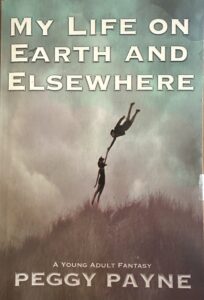Reviewed by Linda C. Brinson
MY LIFE ON EARTH AND ELSEWHERE. By Peggy Payne. Hydra Publications. 332 pages. $18.99, paperback.
Peggy Payne’s new novel is both a bold departure from her past books and another way of exploring the themes that have run through her fiction from the start. Payne, who lives near Chapel Hill, is a distinguished and seasoned author, but she hasn’t simply found her niche and settled in. Reading one of her books is always an adventure, and this may be the most surprising.
 Payne and I are contemporaries. Both of us were well past our “young adult” years when I reviewed Revelation, her widely hailed first novel, 35 years ago.
Payne and I are contemporaries. Both of us were well past our “young adult” years when I reviewed Revelation, her widely hailed first novel, 35 years ago.
Yet in My Life on Earth and Elsewhere, which debuted early this month, she gives us a book that checks the boxes of “young adult,” “teen fiction” and “contemporary fantasy.” And she does a wonderful job.
As it’s been decades since I fit her target demographic, I’m no expert on whether this book will appeal to teenage girls. My educated guess is that it will resonate with many of them. I do remember the angst and insecurities of being a teenage girl, and Payne obviously does too. Who could forget those difficult years? And the dialogue, interactions and first-person narration from the point of view of 16-year-old Darcy ring true with what I hear and see when I’m around young adults.
My Life on Earth …, though quite a departure from Payne’s earlier novels, does share the strong theme that runs through her works – that of spirituality and the many ways it can come into our lives and hearts as we struggle along, heading toward the time when we “shuffle off this mortal coil.”
Her debut novel, Revelation, is an ironic gem. It’s the story of Dr. Swain Hammond, the pastor of a liberal Presbyterian church in Chapel Hill, where intellectual types worship in a predictable, civilized and dignified way. Swain’s life and ministry are thrown into chaos and looming disaster when the unexpected happens: He hears the voice of God unmistakably speaking to him in his backyard.
Sister India, her 2002 novel, tells the story of a lovely young North Carolina woman who flees to India after a violent, traumatic event. She finds refuge in a Hindu holy city, where she takes a new name and hides herself behind hundreds of pounds of flab and a reclusive, angry demeanor. But eventually love and strong, confusing religious feelings draw her into a very different world.
In Cobalt Blue, a commercial artist in Pinehurst, N.C., is living an increasingly constricted life, hungering for something, but not knowing what. One day while working in her studio, she is shocked out of her troubled existence by a sudden and powerful spiritual experience. Her first reaction is to plunge wildly into sexual encounters, something that does not bring the peace she seeks. Her quest takes her on an extended pilgrimage across North Carolina and the South, to India and beyond, as she explores the edges of life where sexuality and spirituality intersect.
Back to My Life on Earth…: 16-year-old Darcy is precocious, intelligent but inexperienced, on the fringes of the popular set at her high school and secure in her role as the beloved only child of a college professor and an artist.
She’s literally jolted out of her body when her parents stun her one evening by announcing that they are separating, that her father is moving into a small apartment. Suddenly Darcy’s inner self is floating in a backyard tree, while she views her parents talking earnestly to her mute body below on the patio. Even more shocking, there is someone with her, standing among the tree limbs. He’s a gorgeous boy about her age. But when he sees her looking at him, he disappears, and Darcy plummets back into her body.
“Imaginary tree guy,” as Darcy thinks of him at first, soon appears more often, if unpredictably, and for longer visits – in unexpected places and even when she’s with other people. Risto, as he calls himself, seems to be from some other sphere of existence, where people behave and dress quite differently. He’s only beginning to speak English, and he continues to sound and act … odd.
She gradually learns that Risto is a young spirit, preparing to be born into human life on Earth at some future time. Despite her skepticism, and worries that her parents’ upheaval is affecting her brain, she becomes increasingly close to him, to the point of falling in love. Most of the time she believes he’s real – even inviting him to her prom – but she also wryly reminds herself that crazy people think they’re sane.
Meanwhile, she gradually learns that the source of her parents’ rift is that her father has changed profoundly. A scientist and professor guided by reason, not faith, he suddenly feels a strong spiritual call, and he’s trying to figure out what he’s being called to do. Darcy would dismiss his thoughts as some sort of fantasy, except that she has come to believe that her own experiences in another spiritual realm are real.
What, indeed, is real? What is astral projection? How can Darcy and Risto live in their different worlds and yet come together? How do any of us reconcile our lives on Earth with whatever spiritual existence we find or are seeking?
This is a compelling story, deceptively light and easy to read. I opened the book with some trepidation, hoping at best to write a useful review. To my surprise, I discovered that, even though I’m far from young and not someone who chooses to read fantasy fiction, I found My Life on Earth and Elsewhere thoroughly enjoyable and – Payne surprises me again – thought- provoking.